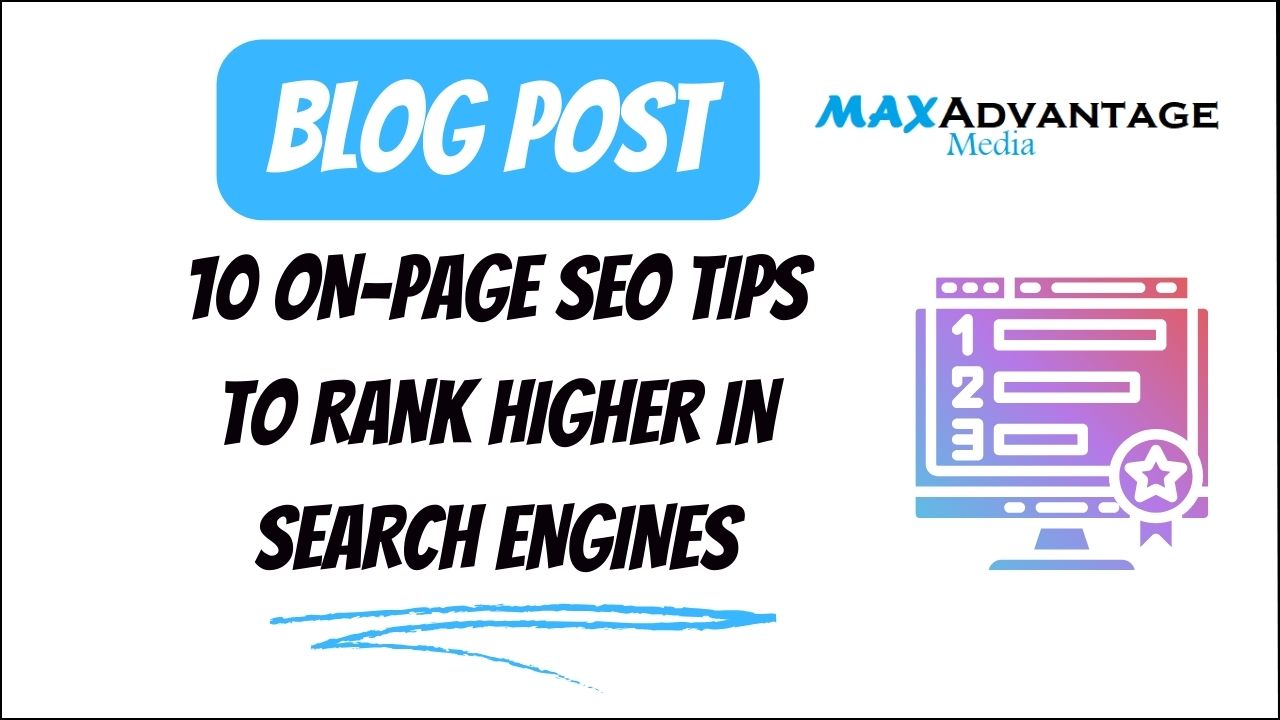 10 On-Page SEO Tips To Rank Higher In Search Engines
10 On-Page SEO Tips To Rank Higher In Search Engines
In this blog post, 10 On-Page SEO Tips To Rank Higher In Search Engines, we unveil indispensable on-page SEO tips that will not only elevate your website’s visibility but propel it to new heights in search engine rankings.
In fact, as search engines continue to refine their algorithms, ensuring that your website stands out amid the digital noise has become more important than ever. Every tweak, adjustment and optimization you make contributes to your website’s ability to communicate effectively with search engine algorithms, dictating how high you’ll rank in search results.
Below we discuss title optimization, meta descriptions, header tags, keyword placement, image optimization, URL structure, internal linking, mobile optimization, page speed optimization, the quintessential element—quality content and how they work together to boost your search engine performance.

Top 10 On-Page SEO Tips For Higher Search Engine Rankings
Here we introduce the significance of optimizing your website for search engines and how these 10 on-page SEO tips can be your compass on the path to business success.
When these on-page SEO tips are implemented in a cohesive manner it creates a synergy and focus for search engines to love your content and website for improved rankings.
1. Website Title Optimization
The gateway to your website’s soul lies in its title – a few carefully chosen words that encapsulate the essence of your content. Title optimization is not just about creating a catchy phrase, it’s a strategic dance with keywords that captivate both users and search engines.
Your title is one of the most important on-page SEO tips and the first impression users have of your content. As the saying goes, “First impressions matter.” A well-crafted title not only grabs attention but sets the stage for what follows. It should be enticing, invoking curiosity while aligning with the user’s search intent. Consider incorporating power words that evoke emotion or urgency, making users more inclined to click. Words like “ultimate,” “essential,” or “exclusive” can add a sense of value to your content.
While creating a captivating title is important, it’s equally important to integrate relevant keywords that align with your content. Think about the terms users might type into a search engine to find information related to your topic. These keywords should naturally fit into your title, signaling to search engines that your content is a relevant match.
Strike a balance between creativity and keyword inclusion. Your title should read seamlessly, avoiding the trap of keyword stuffing. Remember, the goal is to entice both users and search engines, creating a harmonious synergy between engagement and SEO.
2. Meta Descriptions
As users skim through search engine results, the meta description is your website’s elevator pitch – a concise snippet that can either entice or deter a click.
Crafting an engaging meta description involves encapsulating the essence of your content in a brief, persuasive paragraph. It’s your opportunity to convince users that your page holds the answers to their queries.
Consider posing a question or hinting at the value users will gain by clicking. Use language that resonates with your target audience and be mindful of the character limit to ensure your message remains clear and concise.
A well-crafted meta description not only informs users but also boosts click-through rates. By aligning your meta description with the user’s search intent, you increase the likelihood of attracting visitors genuinely interested in your content. Include a call-to-action to encourage engagement. Phrases like “Discover,” “Learn More,” or “Explore” subtly guide users towards taking the desired action – clicking through to your page.
In the grand scheme of on-page SEO, the meta description is your virtual handshake with potential visitors. It shapes their expectations, making the difference between a fleeting glance and a meaningful interaction.
3. Header Tags
In on-page SEO, header tags are the notes that compose the structure and hierarchy of your content. They guide both users and search engines through the structure of your webpage, providing clarity and emphasis where needed.
Headers come in various hierarchies, with H1 being the most important and H6 the least. The H1 tag typically represents the main title of your page and sets the overarching theme. Subsequent tags, such as H2 and H3, break down the content into sections and sub-sections, enhancing readability.
By using these tags appropriately, you provide a roadmap for both users and search engines, signaling the importance and flow of your content. This structured approach not only aids in comprehension but also contributes to the overall SEO of your page.
Search engines value well-structured content. Proper utilization of header tags not only enhances the visual appeal of your page but also helps search engine crawlers understand the thematic hierarchy of your content. This understanding, in turn, contributes to improved rankings by signaling the relevance and organization of your information.
As you implement your on-page SEO strategy, think of header tags as the architects of your content, shaping it into a user-friendly and search engine-optimized masterpiece.
4. Keyword Placement
When creating user-friendly content and search engine visibility, strategic keyword placement takes center stage. The art lies in seamlessly integrating keywords to enhance your page’s relevance without compromising the natural flow of your content.
Strategically placing keywords throughout your content is akin to sprinkling breadcrumbs for both users and search engines to follow. Begin by identifying the primary keyword relevant to your content. This keyword should naturally find its way into critical areas such as the title, headers, and the introductory paragraph.
Distribute related keywords throughout your content, creating a semantic network that reinforces your page’s relevance. However, resist the temptation to overuse keywords – the key is moderation. Search engines appreciate content that reads naturally, ensuring a positive user experience.
While keywords are the compass guiding search engines to your content, the user experience remains paramount. As you strategically place keywords, ensure that your content maintains a natural and engaging flow. Keywords should seamlessly integrate into sentences, contributing to the overall coherence of your message.
Strike a balance between optimizing for search engines and catering to your audience. A well-crafted piece that speaks to your users while appeasing search engine algorithms is the sweet spot for on-page SEO success.
5. Image Optimization
Image optimization is the key to ensuring your visuals contribute not just to the appeal but also to the overall SEO performance of your website.
The optimization of images begins with compression. Large image files can slow down your website’s loading speed, affecting both user experience and search engine rankings. Compressing images without compromising quality is a delicate balance that pays dividends in faster loading times.
Equally crucial, is naming the title and description of your images strategically. Avoid generic names and opt for descriptive filenames that incorporate relevant keywords. This not only aids search engines in understanding your content but also contributes to improved image search rankings.
Additionally, alt text, or alternative text, serves as a textual description of your images. This not only makes your content more accessible to users with visual impairments but also provides valuable context for search engines. When crafting alt text, be descriptive and include relevant keywords where applicable.
In essence, search engines rely on alt text to comprehend the content of an image, contributing to the overall SEO of your page. An added bonus is that well-optimized images can appear in image search results, expanding your website’s visibility.

6. URL Structure
Your website’s URL is more than just an address, it’s a roadmap that guides both users and search engines through the digital landscape. Crafting a clean and readable URL structure is imperative to laying a smooth path towards enhanced visibility.
The first rule of URL optimization is simplicity. A clean and readable URL not only aids users in understanding the content but also signals to search engines that your page is well-organized. Avoid convoluted strings of numbers or symbols and opt for a structure that reflects the hierarchy of your content.
Incorporate relevant keywords into your URL, providing a sneak peek into the content’s subject matter. Remember, a well-crafted URL is not just an address, it’s a concise summary of what awaits the visitor on your page.
Strategic keyword placement extends beyond the confines of your content, it permeates into your URL structure. Include relevant keywords in your URL, aligning it with the user’s search intent. This not only contributes to search engine visibility but also enhances the overall SEO of your page.
Strike a balance between keyword inclusion and readability. A URL should be a user-friendly guide, not a cryptic code. Think of it as a signpost in the digital landscape, directing users and search engines to the heart of your content.
7. Internal Linking
Internal linking serves as the connective tissue that binds your content together. This strategic practice not only enhances user navigation but also contributes to search engine understanding and ranking.
Internal linking involves weaving a network of links that connect various pages within your website. When done strategically, these links guide users to relevant content, extending their stay on your site. From a search engine perspective, internal links contribute to the overall understanding of your website’s structure and content hierarchy.
Ensure that your internal links are contextually relevant. Link to pages that provide additional value or expand on the topic at hand. This not only enriches the user experience but also signals to search engines that your content is interconnected and comprehensive.
Beyond user navigation, internal linking distributes link equity throughout your site. Link equity, also known as link juice, refers to the value passed from one page to another through hyperlinks. By strategically placing internal links, you can ensure that valuable link equity flows to essential pages, boosting their authority in the eyes of search engines.
Consider creating a hub of cornerstone content that serves as a central point for internal links. This hub becomes a powerhouse of authority, and as you strategically link to it from other pages, you amplify its significance in the digital ecosystem.
8. Mobile Optimization
As the digital landscape tilts towards mobile-first experiences, ensuring your website is not just responsive but truly optimized for mobile devices becomes paramount.
Mobile optimization begins with a design that seamlessly adapts to various screen sizes. A mobile-friendly design is not merely about fitting content onto a smaller screen, it’s about crafting an experience that is intuitive, visually appealing and functional on mobile devices.
Elements like touch-friendly buttons, readable text, and optimized images contribute to a positive user experience. A website that delights mobile users not only keeps them engaged but also signals to search engines that your content is accessible and user-centric.
Google, the behemoth of search engines, considers mobile optimization a crucial ranking factor. Websites that prioritize mobile users are rewarded with higher rankings in mobile search results. This emphasis on mobile-friendly experiences aligns with the growing trend of mobile-centric browsing habits across the globe.
Optimizing for mobile isn’t just about meeting a search engine’s criteria, it’s about catering to the evolving needs of your audience. By prioritizing mobile optimization, you not only enhance your search engine visibility but also future-proof your website against the dynamic shifts in user behavior.
9. Page Speed Optimization
In the fast-paced digital world, where attention spans are fleeting, the speed at which your website loads can make or break the user experience. In fact, page speed optimization emerges as a critical element of on-page SEO, influencing both user satisfaction and search engine rankings.
Furthermore, page speed is the heartbeat of your website, determining how swiftly visitors can access your content. A sluggish loading time not only frustrates users but can also lead to higher bounce rates. To optimize loading speed, compress images, leverage browser caching, and minimize unnecessary code.
In addition, consider implementing lazy loading for images, ensuring that images load only as users scroll down the page. This technique contributes to a faster initial page load, providing users with quicker access to essential content.
A myriad of strategies exists to enhance your page’s performance. Utilize Content Delivery Networks (CDNs) to distribute your website’s static content across multiple servers, reducing latency. Minimize HTTP requests by combining CSS and JavaScript files, and prioritize critical content to load first for a smoother user experience.
Google places a premium on page speed, considering it a crucial ranking factor. Faster-loading pages not only keep users engaged but also signal to search engines that your website is efficient and user-centric.
10. Quality Content
Quality content is the bedrock upon which successful on-page SEO strategies stand, influencing not only user engagement but also search engine rankings.
At its core, quality content is a symbiotic fusion of relevance and value. It addresses the needs and queries of your audience while offering insights, solutions, or entertainment. Strive to create content that goes beyond the surface, delving into the intricacies of your subject matter and providing a comprehensive resource for your users.
Conduct thorough research, stay updated on industry trends, and craft content that stands the test of time. When your audience finds value in what you offer, they are more likely to engage, share and return for more.
The metrics of quality extend beyond the written word. Engaging content beckons users to interact, whether through comments, shares, or other forms of participation. Foster a sense of community around your content, encouraging discussions and building a loyal audience.
Search engines take user engagement as a signal of content quality. The more users interact with and share your content, the more favorable your website appears in the eyes of search algorithms. Quality content not only attracts users but also serves as a catalyst for organic growth.
Conclusion
As you navigate the ever-evolving currents of the digital landscape, let these 10 on-page SEO tips to rank higher in search engines be your compass. Strategic optimization isn’t a one-size-fits-all journey, it’s a dynamic, ongoing commitment to excellence. By integrating these tips into your digital strategy, you’re not just aiming for higher search engine rankings, you’re creating a digital presence that delights users and stands out in the vast sea of online content.
Yet, at the core of this intricate web of strategies lies a timeless principle – the significance of quality content. It’s not just about appeasing search algorithms, it’s about crafting an experience that resonates with users, offering them value, relevance and a reason to return.
Let’s Talk: Contact Tim @ MaxAdvantage Media Of Long Island
Ready to transform your online presence and drive business growth? Contact MaxAdvantage Media today and let’s build a SEO strategy that takes your Long Island business to new heights!
Maximize your online visibility, elevate your search engine rankings, and become a local authority in your industry with MaxAdvantage Media’s expertly crafted SEO-driven web design. Contact us today to unlock the full potential of your online presence!
Web Page:
https://maxadvantagemedia.com/services/
Phone:
631-729-0435
Email:
Tim@MaxAdvantageMedia.Com
